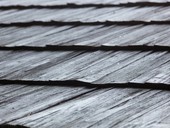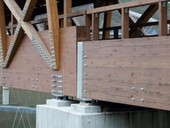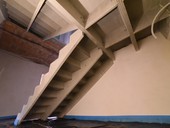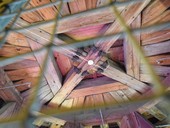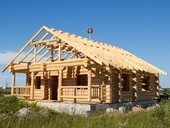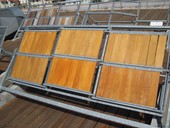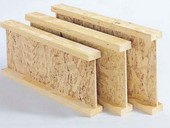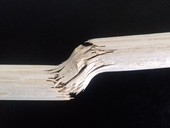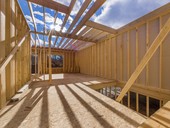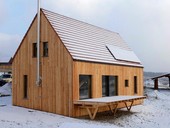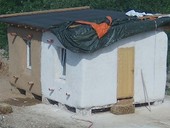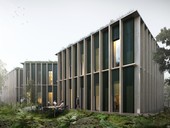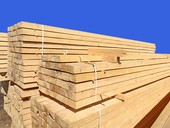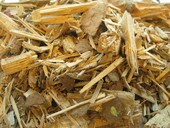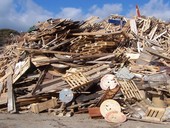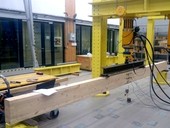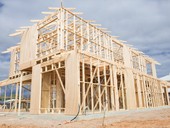Treatment of wood surfaces with various finish coating materials is recommended for long term protection of wood products exposed outdoor. Due to natural weathering, the colour and the surface roughness of uncoated wood is changed. However, in practice it can happen that wood in constructions has been weathered before to application of a finish. In this work, selected properties of sapwood and heartwood of pine (Pinus sylvestris, L.) surface such as surface roughness and adhesion of coating film were investigated on the surfaces of previous naturally weathered wood Two coating materials useable for wooden constructions in exterior conditions were used: dark brown polyurethane-based system and light brown oil-based surface treatment. The results of pull-off test for adhesion showed that the polyurethane coating film showed the weakest point in the pre-weathered layer of wood substrate and also at the wood/coating interface. The oil-based surface treatment had the weakest place inside the coating film or in the coating penetration layer in the wood substrate. Pre-weathering did not significantly affect the adhesion the coating film on wood. The result of the pull-off test for adhesion of both surface treatments was significantly greater on the heartwood surfaces than on the sapwood surfaces of the sound wood.
Archiv článků od 19.3.2018 do 9.9.2019
Survey of the real impact of historical and older constructions and constructions realized in the present period clearly shows that wood and wood-based materials are among efficient and still promising construction materials. The paper is compiled mainly on the basis of the knowledge gained during the verification of the properties of structures, in whose design and implementation the authors participated, and on the evaluation of the results of the survey of structures for the purpose of their remediation or reconstruction.
A wide range of requirements are laid out for stair construction, which are based on general construction requirements. These are mainly structural fire resistance, static resistance, mechanical resistance, appearance requirements and more. This article focuses on existing material and structural solutions for staircases used in modern wooden constructions and on the possibilities of using cement-fibre boards to build a staircase. The article summarizes the general advantages and disadvantages of this solution and represents the basic design solution.
Wood's combustibility and flammability still limits its use as a building material by various constraints. Few realize that wood is flammable, but has a very good fire resistance. The heat-treated wood layer, which is under the carbonated wood layer, is generally very thin (~ 20 & quot; mm & quot; mm), so that the wood properties below this layer are the same as those at normal temperature. Therefore, steelmakers have now begun to look at the possibilities of protecting steel structures against the effects of fire by wooden tiles.
The article is focused on the analysis of connections of timber elements with doweled type steel elements. The main scope of the article is to assess a load bearing capacity and stiffness of different types of doweled connections and comparison of theoretical results with results obtained from experimental tests. Subject of the research were connections composed of C24 grade solid timber elements connected with nails, screws, dowels, threaded rods and bolts. Findings and conclusions derived from the analysis of assumed connections can be used for a design and execution of doweled type connections in timber structures.
The valuation of wooden houses issue is becoming an increasingly discussed topic in the expert practice, not only because the construction of wooden houses is increasing year after year. Firstly, the article is defines individual types of wooden houses. The appraiser can come into contact with the issue of valuation of family wooden houses at various stages of the building´s life cycle. At the construction stage it is necessary to know the individual construction cost. Further, the article deals with the behavior of wooden houses within the real estate market so that the appraiser can determine market price of the building.
Oak wood is characterized by good durability against biotic damages. However, its surface treatment by coatings is problematic, especially in the exterior expositions. In most cases, there is a rapid degradation and damage caused by weathering. Transparent variants of coating systems suffer from this phenomenon even more than pigmented ones. The article contains the results of practical experiments that lead to some general recommendations, which use leads to surface treatment of oak wood in exterior with longer durability and better colour stability.
The subject of this paper is an experimental and numerical analysis of the stability of the wall panels with one-side board sheating. The reinforcement of the panel is provided by means of glued timber composite I-shaped element consisting of a web made of a wood-based desk embedded into flanges of solid timber. The mechanism of the behaviour of these panels, mode of the failure and reliable procedure to determine the buckling load-bearing capacity not been fully explored so far. The main aim of this project is to create reliable numerical model using experiments and parametric study for optimized design. Outcome of the work is a design model and dimension tables for one-side board sheating wall panels of light timber structures with a rib in the form of an I-stud.
Dowel joints with wooden fasteners are an important part of many timber structures. They have been used especially in historical timber structures. This type of fasteners can be used for the construction of modern wooden structures or for the production of individual wooden structural elements, such as the Holz100 system of the Austrian company Thoma or for similar Brettstapel structural elements. Actual normative materials (principally Eurocode 5) do not provide sufficient safe design description for such structural joints. A complex model of failures in different directions to the grain of wood is missing. The article focuses on a pilot study on the evaluation of mechanical behaviour of dowel joints and presents the results of experiments of all-wood joints with dowels made of various wood species.
The paper presents the building-physical context of the use of roof windows in buildings with very low energy demand. It shows their relatively significant influence on the total heat loss of a single family house and the consequence of the specific disadvantageous set-up in the pitched roof. It is shown that the thermal transmittance should not exceed 0.7 W/(m2K) with a strict limitation of thermal coupling in the connection to the roof. In the second part, the paper shows the positive effect of the slanting of the inner lining on the quality of day lighting.
Possibilities of application of clay in the construction of wood-based buildings in terms of increasing their fire protection – history, present. Requirements for fire resistance of outher sheating of wood buildings depending on their fire-height. Application of interior clay plasters in terms of optimization of indoor microclimate and fire protection of lightweight wall sheating in wooden houses in model solution.
In contemporary architecture, straw is used marginally, mostly in do-it-yourself construction. Although the convenient qualities of straw have long been known, it has not gained the trust of builders and designers. Construction companies have not learned to work with straw on a regular basis. In the scope of green technologies, an opportunity is emerging to use straw in professional building systems suitable for sustainable architecture. If we want to apply it in our architectural designs, we have several possibilities. The common small straw bales are suitable for many ways of structure and do-it-yourself process. This way of building process can be interrupt by logistic problems or weather disaster. Contemporary building market offers professional products made of straw: universal strongly pressed boards or system of modular units for external walls. All these ways of application are able to gain the high building quality. The innovative straw technologies enable to design and erect the energy passive house with considerable percentage of straw in constructions. Although the advantages of straw are indisputable, the next success of straw building materials depends on the interest of architects and builders.
The article describes full-scale fire experiment of a single-storey object made of straw bales covered with clay and lime plaster. Motivation, course and results are shown, particularly focused on global fire behaviour in fire of such construction as well as its contribution to separation distances.
It is expected that the new administrative centre of Lesy České republiky would be an exemplary demonstration of the use of wood, which will be used in the form of the building material or in which the importance of wood will be emphasized in another appropriate way. The paper is focused on a proposal that won the international architectural competition in 2016.
The work is focused on the investigation of the formation of gaseous thermal degradation products of retarded firwood. Samples of firwood were impregnated with solutions of 6 inorganic salts, thermally loaded and the arising gaseous products analyzed by SPME-GC-MS. There were 20 compounds identified, the highest amount was achieved for acetic acid and 2-furaldehyde as typical representatives of wood degradation. Most compounds were identified by degradation of samples treated with boric acid solution, at least with ammonium dihydrogenphosphate. The smallest amount of acetic acid and 2-furaldehyde was determined by treating of fir samples with sodium tetraborate solution, which appears to be a very suitable wood treatment agent for fire protection.
Wood and the materials on its basis fulfil the requirements of an ever-evolving and accelerating society. In addition to naturally grown wood, wood-based materials are frequently used as a basic material for production of furniture and for building constructions as well. Looking at changes in waste management, a significant shift from the waste to the circular economy can be observed. The valuable raw materials are kept in the production cycle instead of landfilling or burning. Wood and wooden products can be efficiently separated in waste management, reused and recycled. The so-called wood waste – old furniture, wooden pallets, window and door frames, demolition wood, used lumber, bark and other wood residues can be reused in particleboard production. Particle board manufacturers in the Czech Republic have adopted progressive waste management and currently use 60% of recycled wood into particle boards. A completed life cycle analysis (LCA) of OSB demonstrates that replacing of 50% of natural fibres with recycled wood has significant environmental benefits. The objective is to push furthermore on effective legislation to promote waste material utilization and thus lead to a more sophisticated waste wood collecting.
Wood and the materials on its basis fulfil the requirements of an ever-evolving and accelerating society. In addition to naturally grown wood, wood-based materials are frequently used as a basic material for production of furniture and for building constructions as well. Looking at changes in waste management, a significant shift from the waste to the circular economy can be observed. The valuable raw materials are kept in the production cycle instead of landfilling or burning. Wood and wooden products can be efficiently separated in waste management, reused and recycled. The so-called wood waste – old furniture, wooden pallets, window and door frames, demolition wood, used lumber, bark and other wood residues can be reused in particleboard production. Particle board manufacturers in the Czech Republic have adopted progressive waste management and currently use 60% of recycled wood into particle boards. A completed life cycle analysis (LCA) of OSB demonstrates that replacing of 50% of natural fibres with recycled wood has significant environmental benefits. The objective is to push furthermore on effective legislation to promote waste material utilization and thus lead to a more sophisticated waste wood collecting.
Wood and the materials on its basis fulfil the requirements of an ever-evolving and accelerating society. In addition to naturally grown wood, wood-based materials are frequently used as a basic material for production of furniture and for building constructions as well. Looking at changes in waste management, a significant shift from the waste to the circular economy can be observed. The valuable raw materials are kept in the production cycle instead of landfilling or burning. Wood and wooden products can be efficiently separated in waste management, reused and recycled. The so-called wood waste – old furniture, wooden pallets, window and door frames, demolition wood, used lumber, bark and other wood residues can be reused in particleboard production. Particle board manufacturers in the Czech Republic have adopted progressive waste management and currently use 60% of recycled wood into particle boards. A completed life cycle analysis (LCA) of OSB demonstrates that replacing of 50% of natural fibres with recycled wood has significant environmental benefits. The objective is to push furthermore on effective legislation to promote waste material utilization and thus lead to a more sophisticated waste wood collecting.
The paper deals with the experimental analysis aimed at function verification of fiber optic sensors (Fiber Bragg Gratings). The sensors are used for mechanical stress measurement in wooden load-bearing structures. Glued laminated timber beam with built-in fiber optic sensor system was mechanically loaded during two bending tests. The data obtained using the fiber optic sensors were compared with the results of reference measurement method and analytical calculation.
The magnitude of the load on the walls of tall wooden constructions can be assembled according to the existing standards according to the valid combination equations in several ways. There are differences between the results. Determining the appropriate procedure for determining vertical strength from construction in different parts of building preparation and comparing it with other options is the subject of this paper.
zpět na aktuální články
